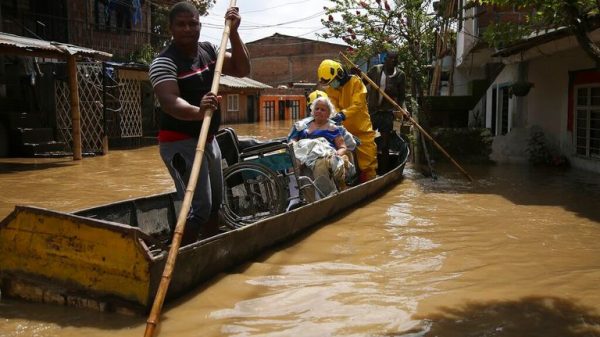In the days following the fall of President Bashar al-Assad, Syrians have crowded his regime’s notorious detention facilities in a desperate search for loved ones who were jailed or forcibly disappeared.
Thousands of prisoners have now been freed, many after decades of incarceration in brutal conditions. Yet many more of the missing have yet to be found, and hopes are fading with each passing hour.
Nearly half a million people were killed during Syria’s 13-year civil war, and up to 100,000 of those victims may have died in government-run prisons, according to UK-based monitoring group the Syrian Observatory for Human Rights.
Mazen al-Hamada
After five decades of Assad family dictatorship was swept away in the last two weeks, one prisoner story has been shared online perhaps more than any other, that of Mazen al-Hamada.
When an uprising against Assad’s iron-fisted rule erupted in spring 2011, al-Hamada was among the first to join and later organize demonstrations in his native city of Deir Ezzor.
He was hopeful, committed and a target of the regime. In 2012, the Air Force Intelligence service, among the state’s most feared security branches, arrested al-Hamada after he smuggled baby formula into a besieged Damascus suburb.
For nearly two years, he was subjected to medieval torture techniques, rapes and beatings, and unspeakable psychological abuse. He later said he confessed to crimes he did not commit when an officer secured a clamp around his penis, screwing it tighter and tighter until the pain made him feel like his mind would burst.
When al-Hamada was released, he returned to Deir Ezzor to find his city in ruins and, fearing for his life, he fled Syria for the Netherlands in 2014.
In Europe, he rose to prominence after detailing the torture he endured in a regime prison in a 2017 documentary.
“They laid me on the ground and broke my ribs,” he said in the film. “ (An officer) would jump up and come down on my body as hard as he could. I could hear my bones snapping.”
The interviewer asked al-Hamada how he felt about his abusers. He paused, swallowing as his eyes filled with tears that then flowed down his gaunt face. “I will not rest until I take them to court and get justice,” he added defiantly. “Justice for me and my friends that were killed.”
And he kept fighting for the cause he loved most – a free Syria. Al-Hamada traveled across Europe and the United States recounting the horrors he suffered in Assad’s prisons, imploring anyone who would listen to help save his people from a ruthless dictator.
He met with journalists, visited White House officials, spoke at the US Holocaust Memorial Museum, and sat down with Senator Marco Rubio.
But nothing changed. The grinding war claimed more lives, and the world’s attention slowly turned away from the tragedy. Assad seemed to have won.
Al-Hamada became jaded, homesick and depressed, said Omar Alshogre, one of his friends and a fellow survivor of the regime’s barbaric prison system. He was talking about going back to Syria, despite the glaring risks.
In 2020, al-Hamada flew back to Damascus, lured by government officials under false pretenses, his family believe. He was picked up shortly after his arrival by security forces and forcibly disappeared.
His friends launched a campaign to find him but never believed they would see him alive again. Until a few days ago, that is, when the rebels burst open Syria’s prisons. But hope was brief.
Pictures of al-Hamada’s body surfaced on social media after his remains were found at a Damascus hospital, believed to have been dumped there by officials from Saydnaya prison, a notorious facility that was nicknamed “the slaughterhouse.”
The image of his hollowed eyes and beaten face permanently etched in horror made the activist yet again a symbol of the country’s suffering and the regime’s brutality, even in its final hours.
“This tells you that even in the last minutes this regime was committing crimes,” Alshogre said. “They never wanted to change. They wanted to be a security state that killed people if they even breathed against the regime.”
Al-Hamada’s story is emblematic of Syria’s suffering. A brave activist who peacefully called for change, a torture victim of Assad’s reign of terror and, ultimately, a dreamer who died in his dungeons.
Yet his harrowing account lives on, and may one day be part of a wider effort to seek justice for the victims.
“His story will always be used as evidence and testimony against this regime that needs to be prosecuted. With that, hopefully we can honor him by bringing justice to Syria,” Alshogre said.
Rania al-Abbasi
When Syria’s uprising began, Rania al-Abbasi, a dentist and national chess champion, was living a comfortable life in Damascus with her husband and six children. They had recently moved back from Saudi Arabia where she had lived and worked alongside her sister Naila.
As the revolt rocked the country, Naila begged her sister to return to Riyadh.
In spring 2013, as the suffering and despair spread, al-Abbasi and her husband made a small but generous donation to a family from a city besieged by the government. It was a simple act of charity that drew the wrath of Assad’s forces.
Members of the regime’s military security branch in Damascus arrested al-Abbasi, her husband and all their children, ranging in age from 1 to 14. They were never heard of again.
In recent days, her sister watched from afar as the regime crumbled. Naila immediately began calling anyone in Syria who might help locate her sister and her family.
“We are speaking to everyone, searching everywhere,” she said. “We are looking for any detail big or small. But we have turned up nothing.”
Naila has campaigned tirelessly for the family’s release, prompting an Amnesty International letter-writing campaign that continued for years. Her efforts led the US State Department to label al-Abbasi a political prisoner, held without just cause. But Naila has never uncovered a single verified detail about her sister’s fate. She only has questions.
“They took children, little children. The youngest was still breastfeeding. She still wore diapers. How?” she said through tears. “They took an entire family. Is it true no one survived? Not even the children?”
In a last-ditch effort, Naila is now searching orphanages across Damascus for her nephews and nieces. Her bond with them runs deep. She is an obstetrician and delivered several of the children herself.
“We should be celebrating, singing and dancing, but without Rania and her family, we cannot feel joy,” she said. “It’s as if our wounds are reopened.”
As time passes, Naila’s hope that she will find her loved ones alive dims. Knowing nothing of their fate is purgatory.
Her agony is shared by the families of an estimated 100,000 disappeared Syrians, according to the United Nations.
“The tyrant is gone, but we need justice,” she said. “Every criminal who drew the blood of our children, our siblings, our parents must face punishment.”
Tal al-Mallouhi
After nearly 15 years apart, Ahd al-Mallouhi can finally hold her beloved daughter, Tal. At age 19, Tal was arrested for posting poems on political and social issues to her blog – she is now 33.
In the first photos taken since her release, Tal flashes a cautious, close-lipped smile. She is wearing a yellow hoodie and a scarf emblazoned with the flag of the opposition.
“I was overwhelmed with an indescribable feeling, a great joy,” her mother told AFP.
But Tal never witnessed the uprising that activists say may have led authorities to keep her in detention, even after her five-year sentence was completed.
In 2009, the high-school student was taken from her home in Homs by Syrian security forces, and her computer, CDs and other possessions confiscated, according to Amnesty International.
After being held incommunicado for months and possibly tortured, Tal was accused of spying for America, an outlandish charge for a teenage blogger. The US State Department condemned what it called a secret trial and dismissed the claims of espionage as “baseless.”
In February 2011, the Supreme State Security court sentenced Tal to five years in prison. She became one of the youngest prisoners of conscience in the Arab world, according to rights groups.
While she was behind bars those numbers swelled. Detention and torture became an integral part of the state’s repression of dissent. And Tal’s case gained international recognition. English Pen, a human rights organization, translated one of her poems to raise awareness.
“My master:
I would like to have power
Even for one day
To build the ‘republic of feelings,’” it concludes.
News of Tal’s survival and freedom spread quickly after the regime’s fall, with so many desperate to hear a story with a happy ending.
But she will need time to recover. Not even her family know what horrors she survived and what scars remain.
“Syria was freed first, then my daughter was released along with all the others,” Ahd told AFP. “Maybe if my daughter had been released alone, I would still fear for her, still be scared they could take her at any moment.”



























